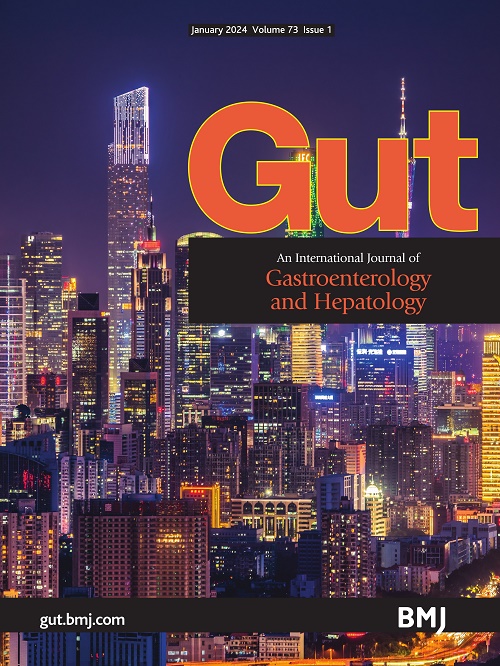通过一种新的阶段性联合治疗:甘氨酸和干扰素-α对HBsAg和HBV cccDNA的治疗性抑制
IF 23
1区 医学
Q1 GASTROENTEROLOGY & HEPATOLOGY
引用次数: 0
摘要
消除HBV共价闭合环状DNA (cccDNA)仍然是慢性乙型肝炎(CHB)治疗的关键障碍。目的研究甘氨酸对干扰素-α (IFN-α)抗病毒作用的潜在增强作用,以刺激肝细胞增殖,降低cccDNA水平。该研究队列包括89名健康个体和496名hbv感染患者,其中30名和42名参与者分别接受随机核苷(t)类似物(NA)和PegIFN-α治疗。采用液相色谱-串联质谱法定量甘氨酸浓度,并通过受试者工作特征曲线分析评估其诊断潜力。通过转录组测序、代谢组测序、流式细胞术、免疫荧光和原位杂交等多种方法,在各种hbv感染细胞系和小鼠模型中评估了甘氨酸的治疗效果。结果hbv感染者血清甘氨酸水平与丙氨酸转氨酶水平呈显著正相关(R=0.7650)。hbeag表达CHB患者与健康对照的曲线下面积为0.9701。补充甘氨酸通过促进肝细胞增殖,降低了约50%的HBV cccDNA水平。甘氨酸被代谢成一个单碳单元,通过甘氨酸转运体-1激活mTORC1信号。此外,甘氨酸通过甘氨酸受体抑制核因子- κ B信号通路,从而改善肝脏炎症。IFN-α联合治疗有效抑制HBV复制,在小鼠中实现HBsAg水平降低60%和持续的病毒抑制。结论甘氨酸可能通过刺激肝细胞增殖来降低HBV cccDNA水平。分阶段给药甘氨酸和IFN-α可显著提高疗效。这些发现为慢性乙型肝炎的治疗提供了一种新颖而有前途的策略。如有合理要求,可提供资料。本文章由计算机程序翻译,如有差异,请以英文原文为准。
Therapeutic inhibition of HBsAg and HBV cccDNA through a novel phased combination treatment: glycine and interferon-α
Background The elimination of HBV covalently closed circular DNA (cccDNA) remains a critical hurdle for chronic hepatitis B (CHB) management. Objective In this investigation, we examined the efficacy of glycine administration and its potential enhancement in interferon-α (IFN-α) antiviral efficacy to stimulate hepatocyte proliferation to mitigate cccDNA levels. Design The study cohort comprised 89 healthy individuals and 496 HBV-infected patients, with subgroups of 30 and 42 participants receiving randomised nucleos(t)ide analogue (NA) and PegIFN-α treatments, respectively. Glycine concentrations were quantified via liquid chromatography‒tandem mass spectrometry, and its diagnostic potential was assessed via receiver operating characteristic curve analysis. The therapeutic impact of glycine was evaluated in various HBV-infected cell lines and murine models via various methodologies including transcriptomic sequencing, metabolomics sequencing, flow cytometry, immunofluorescence and in situ hybridisation. Results Elevated serum glycine levels with a robust positive correlation with serum alanine aminotransferase levels (R=0.7650) were observed in HBV-infected patients relative to healthy controls. The area under the curve for differentiating patients with HBeAg-expressing CHB from healthy controls was 0.9701. Glycine supplementation diminished HBV cccDNA levels by approximately 50% by promoting hepatocyte proliferation. Glycine is metabolised into a one-carbon unit, activating mTORC1 signalling via glycine transporter-1. Furthermore, glycine ameliorates hepatic inflammation by inhibiting the nuclear factor-kappa B signalling pathway through glycine receptors. Combination therapy with IFN-α effectively suppressed HBV replication, achieving a 60% reduction in HBsAg levels and sustained viral suppression in mice. Conclusion Glycine has the potential to reduce HBV cccDNA levels by stimulating hepatocyte proliferation. The phased administration of glycine and IFN-α significantly enhances its therapeutic efficacy. These findings suggest a novel and promising strategy for the treatment of CHB. Data are available upon reasonable request.
求助全文
通过发布文献求助,成功后即可免费获取论文全文。
去求助
来源期刊

Gut
医学-胃肠肝病学
CiteScore
45.70
自引率
2.40%
发文量
284
审稿时长
1.5 months
期刊介绍:
Gut is a renowned international journal specializing in gastroenterology and hepatology, known for its high-quality clinical research covering the alimentary tract, liver, biliary tree, and pancreas. It offers authoritative and current coverage across all aspects of gastroenterology and hepatology, featuring articles on emerging disease mechanisms and innovative diagnostic and therapeutic approaches authored by leading experts.
As the flagship journal of BMJ's gastroenterology portfolio, Gut is accompanied by two companion journals: Frontline Gastroenterology, focusing on education and practice-oriented papers, and BMJ Open Gastroenterology for open access original research.
 求助内容:
求助内容: 应助结果提醒方式:
应助结果提醒方式:


